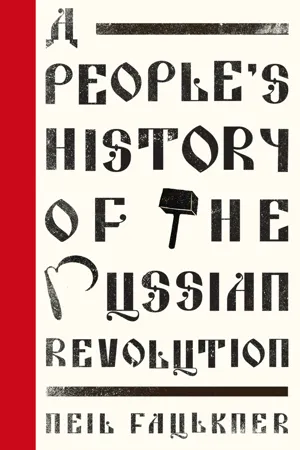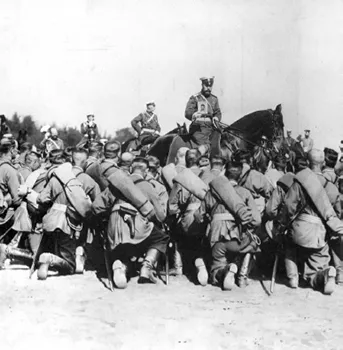![]()
PART ONE
The Spark, 1825–1916
![]()
CHAPTER ONE
The Regime
Medieval mysticism. Russian soldiers – peasants in uniform – kneel as the Tsar passes by waving a holy icon.
The war was going badly, so the Tsar, the supreme ruler of 130 million Russians, had gone to the front to assume personal command. ‘A new page begins, and only God Almighty knows what will be written on it’, he announced. The Tsarina, who had stayed behind at the palace, wrote reassuringly: ‘It will be a glorious page in your reign and Russian history.’ He had nothing to fear, she added, because ‘Our Friend’s prayers arise night and day for you to Heaven, and God will hear them.’ She reminded him that he had been supplied with a holy icon by this ‘Friend’ before setting out – ‘to guard and guide you’ – and later she sent an apple from the hands of the same, one Grigori Rasputin, a Siberian peasant faith-healer, urging her husband to eat it to strengthen his will. Rasputin was a drunkard, a lecher, and a charlatan. With a display of piety and a claim that he could cure her son’s haemophilia, he had insinuated his way into the Court and become the Tsarina’s closest advisor.1
When did this happen? A monarch going to war waving holy icons and eating sacred apples. Not in the twelfth century, but at the beginning of the twentieth.
Tsar Nicholas II, the last of the Romanovs, was a bloodless non-entity riddled with prejudice and superstition, a weak man paralysed by his own stupidity as the fires of war and revolution rose around him. His German wife, the Tsarina Alexandra, was equally benighted and gullible, yet more wilful. Men of talent were dismissed from Court and their places taken by fawning favourites, the appointees of the Alexandra/Rasputin clique, what one former minister called ‘the leprous court camarilla’. In the shallow mind of the Tsarina, this was interpreted as strength. ‘Being firm is the only saving’, she told the Tsar. ‘You are autocrat and they dare not forget it.’ He was to ‘crush them all’, for he was ‘the autocrat without which Russia cannot exist’. As this German aristocrat in a Russian palace explained it: ‘Russia loves to feel the whip. That is her nature. Tender love, and then the iron hand to punish and guide.’2 Thus did the last of the Romanovs meet the challenges of a world of railways, steelworks, and howitzers: with the barbarism of the Middle Ages.
How to explain this travesty? Georgi Plekhanov, the founder of the Russian socialist movement in the late nineteenth century, considered Russia ‘too Europeanised in comparison with Asia, and inadequately Europeanised in comparison with Europe’.3 It was, he implied, an historical hybrid which had entered the industrial age still saddled with an absolute monarch and a state-feudal social structure inherited from the sixteenth century.
To understand the revolution that exploded inside Russia in 1917, we must begin with a ‘deep time’ perspective – a sense, that is, of what the French historians of the Annales tradition call la longue durée. If revolution is ‘compressed’ history – the progress of a century becoming the achievement of a year – it becomes so only because long-accumulating contradictions have reached a critical mass.
The autocratic rule of the Tsars – and the militaristic manner in which Russia came to be ordered – was the result of the interaction of three factors: the backwardness of the economy; the weakness of civil society; and competition with rival powers. Let us consider this interaction in detail, for it provides the seed-bed of the revolutionary crisis to come.
Old Russia
Tsarist Russia eventually comprised a vast territory of diverse geography, multiple ethnicities, and only the most rudimentary communications. It stretched from Poland and the Baltic Sea in the west to the Pacific Ocean in the east, from the icebound wastes of the Arctic in the north to the baking steppes of Central Asia in the south. The continental climate – cold in winter, hot in summer – was harsh. Great tracts of the country – the frozen tundra and taiga forest of the north – remained uncultivated wilderness. Much of the rest was poor land. The belt in which Moscow stands, the historic heart of Old Russia, where the taiga grades into mixed forest, is a region of sand and clay, bogs and marshes, with acidic soils low in humus. Further south again, where the woodland opens into vast expanses of steppe, lies the ‘black earth’ region, where the soil is better, but agriculture is hampered by unreliable rainfall, a short growing season, and, in the past, primitive technique.
Because land was plentiful but poor, Russian agriculture developed extensively: peasant pioneers from the old regions would trek into the wilderness to hack out new farms in successive waves of colonisation. Low yields also encouraged diversification: agriculture was supplemented by fur-trapping, fishing, bee-keeping, and cottage industries producing tools, household goods, clothes, icons, even musical instruments. Village people might be poor, but they were fairly self-sufficient.
This, combined with distance and lack of easy transport, meant that trade and towns were little developed. Most Russians lived in relative isolation. Civil society remained fragmented and unorganised.4 The yeomanry and ‘mechanicals’, the merchant-adventurers and industrial entrepreneurs, the classes of men that had pioneered the development of capitalism in north-west Europe between the sixteenth and eighteenth centuries, were largely absent in Old Russia. ‘The meagreness not only of Russian feudalism, but of all the old Russian history,’ wrote Leon Trotsky, who was both leader and historian of the Russian Revolution, ‘finds its most depressing expression in the absence of real medieval cities as centres of commerce and craft.’5
The extreme centralisation of the Tsarist state was the flipside of Russian society’s atomisation. The autocracy of the Tsar was made possible by the stagnation of urban life, the absence of culture, the void where strong public institutions had failed to develop. But instead of offering a paternal hand, Tsarism was like a brutal rider forcing forwards an overburdened mule; the state followed its own independent historical path, regarding the inert mass of humanity over which it presided as mere raw material for fashioning into a military machine. Under the pressure of geopolitical competition with rival powers, the Tsarist state became an end in itself. Its inner essence was politico-military accumulation: the amassing of manpower and military hardware as a means of empire-building. The Tsar did not exist to serve the people; they existed to serve him.
The last Tsar, Nicholas II, clung to this principle to the very end. With discontent rising all around him, isolated even within the Court itself, the British ambassador, Sir George Buchanan, asked the Tsar in late 1916 whether he should not make some effort to regain the confidence of his people. There was a long pause. Then Nicholas Romanov replied: ‘Do you mean that I am to regain the confidence of my people, or that they are to regain my confidence.’6
Because of primitive technique, rural poverty, and medieval infrastructure, only a regime of exceptional ruthlessness could accumulate the resources necessary to sustain the apparatus of global power. Russia’s engine of war was fuelled by peasant muscle and blood. The method of extraction, from a hundred thousand villages spread across 5,000 miles, was necessarily crude and brutal.
The combination of backwardness and militarism gave to the Tsarist autocracy what Georgi Plekhanov and other contemporary Marxists considered an ‘Asiatic’ character. Russian history knew no Reformation, barely any Enlightenment, and only a most belated Industrial Revolution. Nothing compared with the Dutch, English, American, or French Revolutions. And in that great ‘Springtime of Peoples’ in 1848 – a rolling wave of popular insurrection sweeping through Paris, Berlin, Vienna, Budapest, and Rome – the Tsar, stepping forth as ‘gendarme of Europe’, employed his servile peasant-conscripts to shoot down the democratic revolutionaries on the barricades.
Militarism
The Russian tsars inherited much of their historic character from the Mongol khans. In the early thirteenth century, the Mongols had thundered across the steppes to create an empire that stretched the length of Asia. When their empire broke up in the later thirteenth century, a Mongol-Tartar (or Mongol-Turkic) khanate known as ‘the Golden Horde’ emerged in the north-western region of Central Asia. The princes of Moscow – protected somewhat by their location deep within the Russian hinterland, and enriched by the trade lines that ran through their territory – maintained a precarious semi-independence on the borders of the Golden Horde through craven submission to their Tartar overlords, serving them, in Marx’s words, as ‘hangman, sycophant, and slave-in-chief’. Then, as Tartar power waned, the princes of Moscow – formed in a mould of ‘Asiatic’ despotism, imbued with the instincts of the bully and the barbarian – took stage as masters in their own right.7
Landlocked, without defensible ‘natural frontiers’, surrounded by enemies, the embryonic state of Muscovy was compelled to fight for survival – and, eventually, supremacy – against the Tartar khanates of the disintegrating Golden Horde in the south-east, the feudal kingdom of Poland-Lithuania in the west, and the mercantile city-state of Novgorod in the north. The creation of a national state was mainly the work of Ivan the Great (1462–1505). During his reign, and that of his son, the territory of Muscovy increased six-fold. As it grew, a new class of dependent feudal landowners was created, men who held estates in return for service.8 Yet greater conquests followed.
Ivan the Terrible (1533–84) was the first Muscovite ruler to proclaim himself Tsar (‘Caesar’). So feared was he by his own people that they tolled the church bells to warn of his approach. A mentally deranged tyrant, he used mass murder to create a centralised royal dictatorship and double the size of Muscovy from 2.8 to 5.4 million square miles. Novgorod lost its independence. Rival Slavic princes were struck down. And, equipped with cannon, muskets, and holy icons, the Orthodox Christian soldiers of the Tsar dispersed the Islamic horse-archers of the Golden Horde to push the boundaries of the state to the Ural Mountains and the C...

